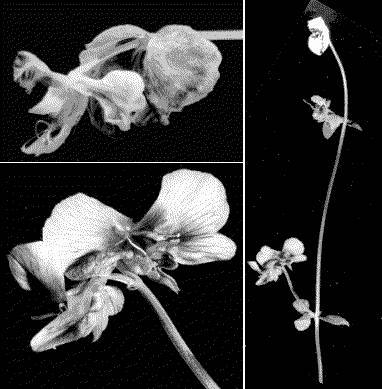
A new homeotic gene, biv, affects flower and inflorescence structures, and displays linkage with d.
Rozov, S.M., Gorel, F.L., Institute
of Cytology and Genetics
Kosterin, O.E. and Berdnikov, V.A. Novosibirsk
630090, Russia
The new mutant SGE-0666, isolated from the M2 progeny of EMS-treated line SG, is characterized by a complex of flower and inflorescence abnormalities (Fig. 1). Although this complex affects almost all flowering structures, not all flowers on one plant are modified to the same degree and in the same manner. In some instances, nearly normal flowers are produced.
The flowers of the SGE-0666 mutant are visibly open from the very early stage of flower bud development. The small buds commonly look like a star structure of widely spread sepals, with the anthers and pistil clearly visible in the center; these buds usually lack petals. Even well developed flowers of normal size very often have no petals, but in such cases some of the sepals develop into petaloid structures very similar to normal petals. Very often these flowers form two symmetrically positioned standard petals (sails) in the upper part of a flower, developed from two upper sepals. Therefore the mutant gene was called biv (bivexillum) following confirmation of single gene recessive inheritance of the trait. The number of stamens in a mutant flower is sometimes reduced to 5-7. In some cases the flowers contain structures intermediate between petals and stamens. The pistil and ovary are probably the only flower structures not affected by the biv mutation. If the pollen gets to the pistil, the ovaries produce normal seeds. Although the number of stamens is sometimes reduced, the anthers contain normal pollen grains.
The inflorescence of the SGE-0666 mutant line is often two to three times longer than the inflorescence of the initial line SG. Sometimes the inflorescence of the biv plants contains large bract-like structures of very varying shape intermediate between that of bracts and stipules. Very often the apical meristem of the shoot of biv plants produces a long inflorescence-like structure. Sometimes this structure consists of several nodes, marked with bract or stipule-like rings, but without leaves and with a single flower on the top. In such cases the plant looks like one with a determinate type of stem – the stem stops its growth due to transformation of the apical meristem into generative organs, and the further growth of the plant continues by means of axillary buds at the lower nodes.
We suggest biv to be a homeotic gene, as it controls transformation of one plant organ to another: stem structures are transformed to an inflorescence, and organs from one floral whorl are converted to flower structures of a different whorl.
Line SGE-0666 was crossed with tester lines WL-1238 and WL-1514. F2 data revealed significant linkage of the biv gene with marker d (Table 1). Unfortunately, there were no other markers from the d-segment involved in these crosses, so it was not possible to establish the relative position of biv on the linkage map.
Table 1. Joint segregation data for genes biv and d obtained from the F2 of the following crosses: 1) SGE-0666 (biv) ¥ WL1238 (d); 2) SGE-0666 ¥ WL1514 (d).
|
Cross |
Phase |
Phenotype |
Joint |
RCV |
SE |
|||
|
Biv D |
Biv d |
biv D |
biv d |
Chi-sq |
||||
|
1) |
R |
320 |
115 |
133 |
9 |
25.6*** |
28.0 |
3.8 |
|
2) |
R |
221 |
89 |
102 |
8 |
21.0*** |
28.1 |
4.4 |
***P < 0.0001.
Acknowledgement: This work was partially supported by the Russian State Program for Fundamental Research.
* * * * *

Fig. 1. Anomalous flowers and an inflorescence (right) of mutant line SG-0666 (biv).